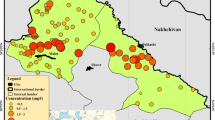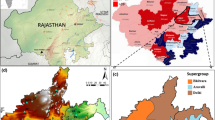Abstract
To assess the status of severity of fluoride contamination in lateritic Bankura and Purulia districts of West Bengal, concentrations of fluoride in different water sources and agricultural field soils were investigated. The fluoride content (mg/l) was observed to differ with aquifer depths: 0.19–0.47 in dug wells, 0.01–0.17 in shallow tube wells, and 0.07–1.6 in deep tube wells. Fluoride within the World Health Organization (WHO) prescribed range (1.0–1.5 mg/l) was estimated only in ~17 % of the total collected water samples while ~67 % showed <0.7 mg/l fluoride and thus may impede in the production and maintenance of healthy teeth and bones of the residents, especially children. Fluoride in water was found to be significantly correlated (r = 0.63) with pH. The exposure dose of fluoride (mg/kg/day) from drinking water in infants, children, and adults was estimated in the ranges 0.02–0.53, 0.01–0.24, and 0.01–0.14, respectively against the standard value of 0.05. A clear risk of dental fluorosis is apparent in infants and children of the study area. The fluoride in soil (55–399 mg/kg) was detected to be significantly correlated with the fluoride content in deep tube wells and soil pH (r = 0.56 and 0.71, respectively). The relationships of soil fluoride with total hardness and that with phosphate were not significant. There is a high possibility of bioaccumulation of fluoride from contaminated soil and water of the study area to cultivated crops. This will enhance the quantity of fluoride intake into human food chain in addition to drinking water pathway.





Similar content being viewed by others
References
Andezhath SK, Susheela AK, Ghosh G (1999) Fluorosis management in India: the impact due to networking between health and rural drinking water supply agencies. Interdiscip Perspect Drink Water Risk Assess Manag 260:159–165
APHA (2005) Standard methods for the examination of water and wastewater, 21st edn. American Public Health Association, Washington
Ayoob S, Gupta AK (2006) Fluoride in drinking water: a review on the status and stress effects. Crit Rev Environ Sci Technol 36:433–487
Bhattacharya HN, Chakrabarti S (2011) Incidence of fluoride in the groundwater of Purulia district, West Bengal: a geo-environmental appraisal. Curr Sci 101(2):152–155
BIS (2003) Indian standard specifications for drinking water. IS:10500, Bureau of Indian Standards, New Delhi. http://wbpcb.gov.in. Accessed 2 Aug 2014
Brindha K and Elango L (2011) Fluoride in groundwater: causes, implications and mitigation measures. In: Monroy SD (ed) Fluoride properties, applications and environmental management. Nova Science Publishing, pp 111–136
Brindha K, Rajesh R, Murugan R, Elango L (2011) Fluoride contamination in groundwater in parts of Nalgonda District, Andhra Pradesh, India. Environ Monit Assess 172:481–492
Census (2011) Bankura district: Census 2011 data, Government of India. http://www.census2011.co.in/census/district/13-bankura.html. Accessed 13 Aug 2014
Chakrabarti S, Bhattacharya HN (2013) Inferring the hydro-geochemistry of fluoride contamination in Bankura district, West Bengal: a case study. J Geol Soc India 82(4):379–391
Chatterjee A, Roy RK, Ghosh UC, Pramanik T, Kabi SP, Biswas K (2008) Fluoride in water in parts of Raniganj Coalfield, West Bengal. Curr Sci 94(3):309–311
Clark RG, Stewart DJ (1983) Fluorine. In: Grace NE (ed) The mineral requirements of grazing ruminants. New Zealand Society of Animal Production, Occasional Publication 9:129–134
Dar MA, Sankar K, Dar IA (2011) Fluorine contamination in groundwater: a major challenge. Environ Monit Assess 173:955–968
Davison A, Weinstein LW (1998) The effects of fluorides on plants. Earth Island 13:257–264
EPA (1997) Public health global for fluoride in drinking water. Pesticide and Environmental Toxicology, Section Office of Environmental Health Hazard Assessment, Environmental Protection Agency, California
Farooqi A, Masuda H, Siddiqui R, Naseem M (2009) Sources of arsenic and fluoride in highly contaminated soils causing groundwater contamination in Punjab, Pakistan. Arch Environ Contam Toxicol 56:693–706
Fornasiero RB (2001) Phytotoxic effects of fluoride. Plant Sci 161:979–985
Grimaldo M, Borja V, Ramirez AL, Poncce M, Rosas M, Diaz-Barriga F (1995) Endemic fluorosis in San Luis Potosi, Mexico: identification of risk factor associated with human exposure to fluoride. Environ Res 68:25–30
Hall RJ, Cain RG (1972) Organic fluorine in tropical soils. New Phytol 71:839–853
ICMR (1975) Manual of standards of quality for drinking water supplies, special report series number 44, 2nd edn. Indian Council of Medical Research, New Delhi
Jha SK, Nayak AK, Sharma YK (2009) Fluoride occurrence and assessment of exposure dose of fluoride in shallow aquifers of Makur, Unnao district, Uttar Pradesh, India. Environ Monit Assess 156:561–566
Kalinic N, Hrsak J, Vadjic V, Lambasa-Belak Z, Mihelcic V, Perkovic B (2005) Fluoride content in soil and vegetation. Bull Environ Contam Toxicol 75:157–162
Khaiwal R, Garg VK (2007) Hydro-chemical survey of groundwater of Hisar city and assessment of defluoridation methods used in India. Environ Monit Assess 132:33–43
Kozyrenko MM, Artyukovo EV, Shmakov VN, Konstantinov YM (2007) Effect of fluoride pollution on genetic variability of Larix gmelinii (Poaceae) in East Siberia. J For Res 12:388–392
Kundu MC, Mandal B (2009) Agricultural activities influence nitrate and fluoride contamination in drinking groundwater of an intensively cultivated district in India. Water Air Soil Pollut 198:243–252
McQuaker RN, Gurney M (1977) Determination of total fluoride in soil and vegetation using an alkali fusion selective ion electrode technique. Anal Chem 49:53–56
Mishra PC, Meher K, Bhosagar D, Pradhan K (2009) Fluoride distribution in different environmental segment at Hirakud Orissa (India). Afr J Environ Sci Technol 3(9):260–264
O’Malley (1995) Bankura. Bengal District Gazetteers, Government of West Bengal, pp 1–20
Ortiz D, Castro L, Turrubiartes F, Milan J, DiazBarriga F (1998) Assessment of the exposure to fluoride from drinking water in Durango, Mexico, using a geographic information system. Fluoride 31(4):183–187
PHED Report (2007) Activities & achievements in rural drinking water supply and other areas. http://www.wbphed.gov.in/applications/im/uploads/000643.pdf. Accessed 18 Aug 2014
Pickering WF (1985) The mobility of soluble fluoride in soils. Environ Pollut B9:281–308
Ramanaiah SV, Venkatamohan S, Rajkumar B, Sarma PN (2006) Monitoring of fluoride concentration in groundwater of Prakasham district in India: correlation with physico-chemical parameters. J Environ Sci Eng 48:129–134
Rao NS (2009) Fluoride in groundwater, Varaha River Basin, Visakhapatnam District, Andhra Pradesh, India. Environ Monit Assess 152:47–60
Rao NVR, Rao KS, Schuiling RD (1993) Fluoride distribution in waters of Nalgonda district, Andhra Pradesh, India. Environ Geol 21:84–89
Saini P, Khan S, Baunthiyal M, Sharma V (2013) Mapping of fluoride endemic area assessment of F−1 accumulation in soil and vegetation. Environ Monit Assess 185(2):2001–2008
Salve PR, Maurya A, Kumbhare PS, Ramteke DS, Wate SR (2008) Assessment of groundwater quality with respect to fluoride. Bull Environ Contam Toxicol 81:289–293
Sankararamakrishnan N, Sharma AK, Iyengar L (2008) Contamination of nitrate and fluoride in groundwater along the Ganges Alluvial Plain of Kanpur district, Uttar Pradesh, India. Environ Monit Assess 146:375–382
Steinberg CL, Gardner DE, Smith FA, Hofge HC (1955) Comparison of rheumatoid (ankylosing) spondilitis and crippling fluorosis. Ann Rheum Dis 14:378–384
Susheela AK (1999) Fluorosis management programme in India. Curr Sci 77:1250–1256
Suthar S, Garg VK, Jangir S, Kaur S, Goswami N, Singh S (2008) Fluoride contamination in drinking water in rural habitations of Northern Rajasthan, India. Environ Monit Assess 145:1–6
UNICEF (1999) States of the art report on the extent of fluoride in drinking water and the resulting endemicity in India. Report by fluorosis and rural development foundation for. UNICEF, New Delhi
USEPA (2010) Drinking water treatability database: fluoride. http://iaspub.epa.gov/tdb/pages/contaminant/contaminantOverview.do?contaminantId=10700. Accessed 23 Oct 2014
USPHS (1962) Drinking water standards. USPHS publications, USGPO, Washington DC, p 956
WHO (2006) Fluoride in drinking water. IWA publishing, London, p 144
Wood JM (1974) Biological cycles for toxic elements in the environment. Science 183:1049–1052
Acknowledgments
The authors are thankful to the Department of Environmental Science, University of Kalyani, West Bengal, India, for providing the laboratory facilities. This study would not have been possible without the help of many. Among them, the greatest help in preparing the samples prior to analysis came from Amrita Chaudhuri and Soume Pyne. Piyal Bhattacharya is thankful to Mousumi Bhattacharya for her cooperation during writing this article. The authors are also thankful to the critical comments of the anonymous reviewers that helped to improve the manuscript considerably.
Author information
Authors and Affiliations
Corresponding author
Additional information
Responsible editor: Philippe Garrigues
Alok C. Samal and Piyal Bhattacharya contributed equally to the work
Rights and permissions
About this article
Cite this article
Samal, A.C., Bhattacharya, P., Mallick, A. et al. A study to investigate fluoride contamination and fluoride exposure dose assessment in lateritic zones of West Bengal, India. Environ Sci Pollut Res 22, 6220–6229 (2015). https://doi.org/10.1007/s11356-014-3817-4
Received:
Accepted:
Published:
Issue Date:
DOI: https://doi.org/10.1007/s11356-014-3817-4




